Boudhanath
| Bouddha Stupa बौद्ध स्तूप | |
|---|---|
 Bouddha Stupa Panorama | |
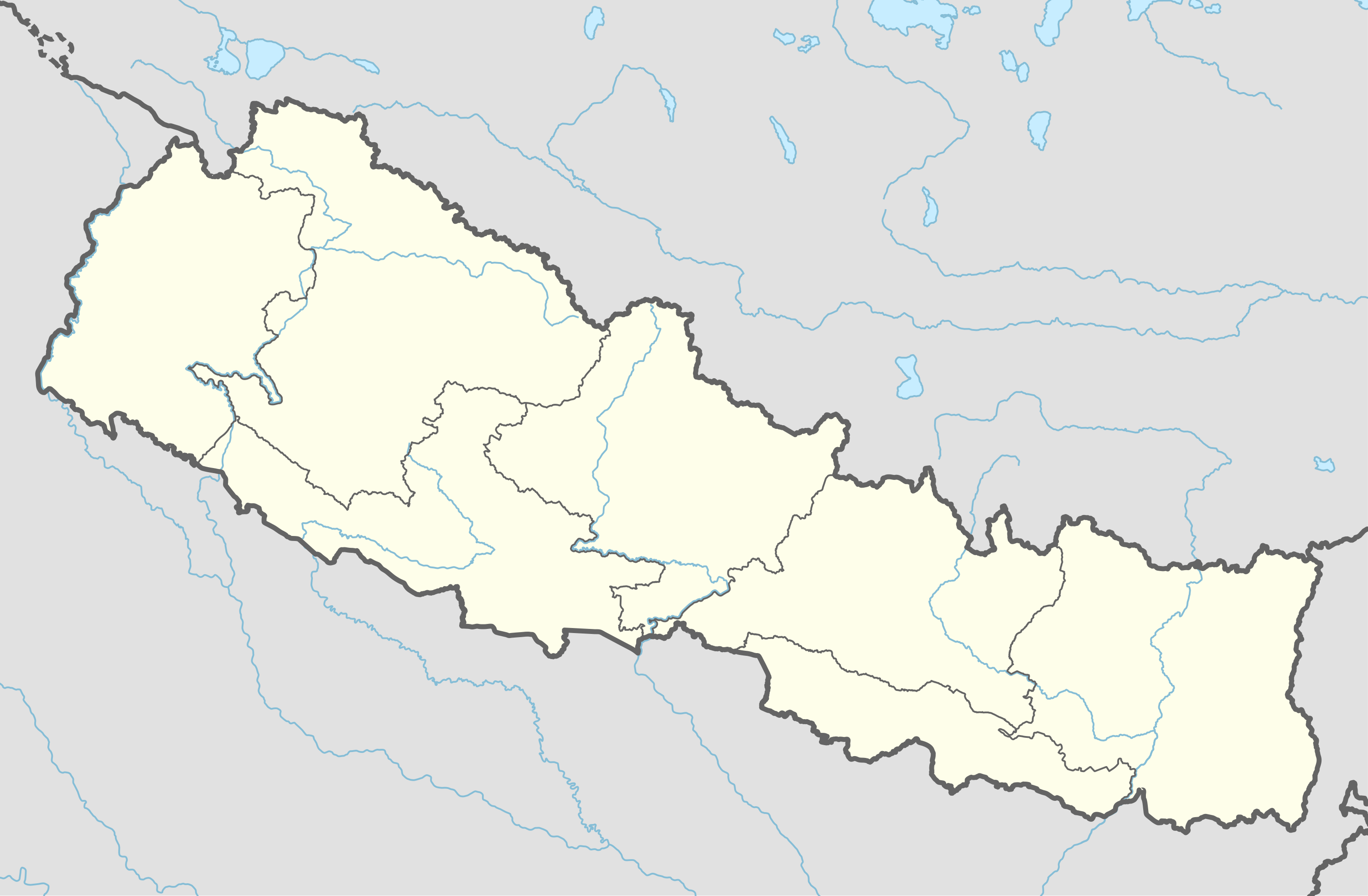 Shown within Nepal | |
| Basic information | |
| Location | Kathmandu, Nepal |
| Geographic coordinates | 27°43′17″N 85°21′43″E / 27.72139°N 85.36194°ECoordinates: 27°43′17″N 85°21′43″E / 27.72139°N 85.36194°E |
| Affiliation | Buddhism, Hinduism |
| Architectural type | Stupa |
| Height (max) | 36 metres (118 ft)[1] |
| Official name: Bauddhanath, part of Kathmandu Valley | |
| Type | Cultural |
| Criteria | iii, iv, vi |
| Designated | 1979 (3rd session), revised 2006 |
| Reference no. | 121bis-005 |
| State Party |
|
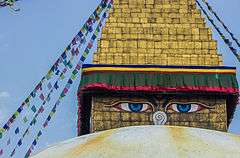
Boudhanath (Nepali: बौद्ध स्तुप, also called the Khāsa Chaitya, Newari Khāsti, Standard Tibetan Jarung Khashor, Wylie: bya rung kha shor ) is a stupa in Kathmandu, Nepal.[2] Located about 11 km (6.8 mi) from the center and northeastern outskirts of Kathmandu, the stupa's massive mandala makes it one of the largest spherical stupas in Nepal.[3]
The Buddhist stupa of Boudha Stupa dominates the skyline; it is one of the largest stupas in the world. The influx of large populations of refugees from Tibet has seen the construction of over 50 gompas (Tibetan convent) around Boudha. As of 1979, Boudha Stupa is a UNESCO World Heritage Site. Along with Swayambhu, it is one of the most popular tourist sites in the Kathmandu area.
The Stupa is on the ancient trade route from Tibet which enters the Kathmandu Valley by the village of Sankhu in the northeast corner, passes by Boudha Stupa to the ancient and smaller stupa of Chā-bahī named Charumati Stupa (often called "Little Boudhanath"). It then turns directly south, heading over the Bagmati River to Lalitpur - thus bypassing the main city of Kathmandu (which was a later foundation).[2] Tibetan merchants have rested and offered prayers here for many centuries. When refugees entered Nepal from Tibet in the 1950s, many decided to live around Boudhanath. The Stupa is said to entomb the remains of Kassapa Buddha.
Mythology
Legend of the construction of the stupa according to Newar Buddhist mythology
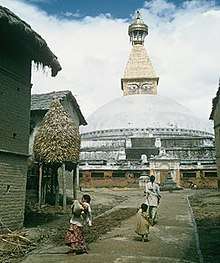
According to the history of Nepal, the palace of King Bikramaditya (Licchavi King) once stood where the Narayanhity Palace currently stands. King Vikramaditya instructed that a Dhunge Dhara should be built in the southern part of palace courtyard. But there was no sign of water from the Dhunge Dhara, for which the king consulted Astrologers. Astrologers suggested that a Human sacrifice with a male candidate having Battis-Lakshanas, or thirty-two perfections[4] should be performed. Only the king himself and his two princes were suitable candidates. So, the king decided to sacrifice himself and ordered one of his sons to sacrifice him so that sign of water could be seen at the Dhunge Dhara. According to local mythology, during the time of sacrifice, the head flew off to a place nearby Sankhu Bajrayogini Temple[5].
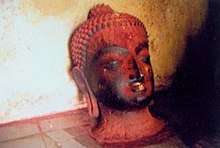
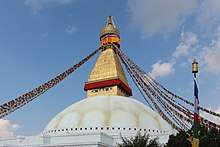
The prince then with a regretful heart, flew a hen from the top of Bajrayogini and decided to construct a Stupa where the hen landed. The hen landed in the place where Boudhanath Stupa is currently standing. During the same time, the place was struck with a Drought and the people managed to abate the scarcity of water by collecting the droplets of dew. So, the place was named Khāsti as in Nepal Bhasa, "khas" refers to dew and "ti" refers to drops.
Later His Majesty Government of Nepal renamed the place from Khasti to Boudhanath in order to reflect Hinduism as being the Hindu Nation.
Legend of the construction of the stupa according to Tibetan Buddhist mythology
- "The village that surrounds the great Kāśyapa stupa is generally known by the name of Bauddha. ...which in Tibetan is called Yambu Chorten Chenpo (Tibetan: ཡམ་བུའི་མཆོད་རྟེན་ཆེན་པོ། Wylie: yam bu'i mchod rten chenpo). Yambu is the general name by which Kāthmāndu is known in Tibet, and Chorten Chenpo means great stupa. The real name of the stupa in full is, however, Jya Rung Khashor Chorten Chenpo, which may be translated into: "Have finished giving the order to proceed with." The stupa has an interesting history of its own which explains this strange name. It is said in this history that Kāśyapa was a Buddha that lived a long time before Śākyamuni Buḍḍha. after Kāśyapa Buddha's demise, a certain old woman, with her four sons, interred this great sage's remains at the spot over which the great mound now stands, the latter having been built by the woman herself. Before starting on the work of construction, she petitioned the King of the time and obtained permission to "proceed with" building a tower. By the time that, as a result of great sacrifices on the part of the woman and her four sons, the groundwork of the structure had been finished, those who saw it were astonished at the greatness of the scale on which it was undertaken. Especially was this the case with the high officials of the country, who all said that if such a poor old dame were allowed to complete building such a stupendous tower, they themselves would have to dedicate a temple as great as a mountain, and so they decided to ask the King to disallow the further progress of the work. When the King was approached on the matter his Majesty replied: "I have finished giving the order to the woman to proceed with the work. Kings must not eat their words, and I cannot undo my orders now." So the tower was allowed to be finished, and hence its unique name, "Jya Rung Khashor Chorten Chenpo." I rather think, however, that the tower must have been built after the days of Śākyamuni Buddha, for the above description from Tibetan books is different from the records in Sanskrit, which are more reliable than the Tibetan." the biggest stupa in Nepal[6]
History
The Gopālarājavaṃśāvalī says Boudhanath was founded by the Nepalese Licchavi king Śivadeva (c. 590-604 CE); though other Nepalese chronicles date it to the reign of King Mānadeva (464-505 CE).[7][8] Tibetan sources claim a mound on the site was excavated in the late 15th or early 16th century and the bones of King Aṃshuvarmā 605-621 were discovered there.[9]
However, the emperor Trisong Detsen (r. 755 to 797) of the Tibetan Empire is also traditionally associated with the construction of the Boudhanath Stupa. The Yolmo Shakya Zangpo from Helambu resurrected Boudhanath.[10]
2015 Earthquake
.jpg)

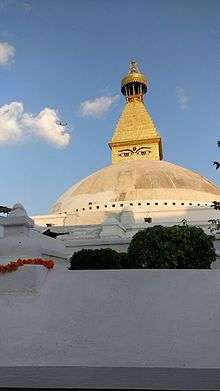
The April 2015 Nepal earthquake badly damaged Boudhanath Stupa, severely cracking the spire. As a result, the whole structure above the dome, and the religious relics it contained had to be removed, which was completed by the end of October 2015. The reconstruction began on 3 November 2015 with the ritual placement of a new central pole or "life tree" for the stupa at the top of the dome.[11]
After earthquake on 2015 photo gallery
 Wide view of Boudhanath Stupa
Wide view of Boudhanath Stupa Eyes of Boudhanath
Eyes of Boudhanath Boudhanath
Boudhanath A view of Boudhanath Premises
A view of Boudhanath Premises Boudhanath in the full moon day and Buddhajayanti
Boudhanath in the full moon day and Buddhajayanti Rain and public walking around Boudhanath
Rain and public walking around Boudhanath A bell in Boudhanath temple
A bell in Boudhanath temple Buddhists praying during a renovation of Boudhanath temple
Buddhists praying during a renovation of Boudhanath temple- Boudhanath in the full moon day and Buddhajayanti
- Boudhanath in the full moon day and Buddhajayanti
 One of world heritage site of Nepal Boudhastupa
One of world heritage site of Nepal Boudhastupa Boudhanath after renovation.
Boudhanath after renovation. Boudhanath after renovation.
Boudhanath after renovation. Boudhanath
Boudhanath
See also
References
- ↑ Department of Archaeology (Nepal). "Bouddha Stupa". Retrieved 3 May 2014.
- 1 2 Snellgrove, David. Indo-Tibetan Buddhism: Indian Buddhists and Their Tibetan Successors, 2 vols., p. 365. (1987) Shambhala Publications, Boston. ISBN 0-87773-311-2 (v. 1); ISBN 0-87773-379-1 (v. 2).
- ↑ "Fables of Boudha Stupa and Changunarayan". nepalnews.com. Archived from the original on 2007-02-09. Retrieved 2007-07-30.
- ↑ "खास्ति चैत्य? बौद्धनाथ ? झ्यारुङ खास्योर ?". Rukshana Kapali. 2016-09-25. Retrieved 2018-01-25.
- ↑ "Bikram Sambat in Nepal". www.vijayvaani.com. Retrieved 2018-01-25.
- ↑ Ekai Kawaguchi. Three Years in Tibet, (1909), pp. 35-36. Reprint: Book Faith India, Delhi (1995). ISBN 81-7303-036-7.
- ↑ Shah, Rishikesh (1990). Ancient and Medieval Nepal. Ratna Pustak Bhandar. p. 123. ISBN 978-0-7855-0252-4.
- ↑ Ehrhard, Franz-Karl (1990). "The Stupa of Bodhnath: A Preliminary Analysis of the Written Sources." Ancient Nepal - Journal of the Department of Archaeology, Number 120, October–November 1990, pp. 1-6.
- ↑ Ehrhard, Franz-Karl (1990). "The Stupa of Bodhnath: A Preliminary Analysis of the Written Sources." Ancient Nepal - Journal of the Department of Archaeology, Number 120, October–November 1990, pp. 7-9.
- ↑ The Legend of the Great Stupa and The Life Story of the Lotus Born Guru, pp. 21-29. Keith Dowman (1973). Tibetan Nyingma Meditation Center. Dharma Books. Berkeley, California.
- ↑ "Boudha Stupa". Nepal Trekking. Retrieved 28 Nov 2016.
Further reading
- The Legend of the Great Stupa and The Life Story of the Lotus Born Guru. Keith Dowman. (1973). Tibetan Nyingma Meditation Center. Dharma Books. Berkeley, California.
- Psycho-Cosmic Symbolism of the Buddhist Stūpa. Lama Anagarika Govinda. (1976) Dharma Books. Berkeley, California. ISBN 0-913546-35-6; ISBN 0-913546-36-4 (pbk).
- Korn, Wolfgang (2015), The Traditional Newar Architecture of the Kathmandu Valley: The Stūpas and the Chaityas, Kathmandu, Nepal: Ratna Pushtak Bhandar, ISBN 9789937330848, OL 26451007M
- Karki, Binod; Shrestha, Sachin Yagol (2016), The Great Boudha Stupa, Kathmandu, Nepal: Shree Boudhanath Area Development Committee, ISBN 9789937005326
External links
| Wikimedia Commons has media related to Boudhanath. |
| Wikivoyage has a travel guide for Boudhanath. |
- Kathmandu heritage sites listed by UNESCO Nepal
- Boudhanath at Khandro.net : Information on Legends and Prophecies
